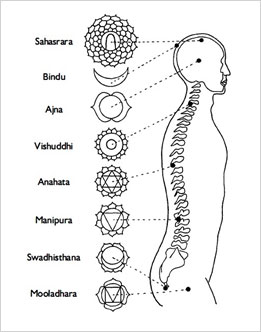Definition of chakra
The word chakra literally means 'wheel' or 'circle', but in the yogic context a better translation is 'vortex' or 'whirlpool'. The chakras are vortices of pranic energy at specific areas in the body which control the circulation of prana permeating the entire human structure. They relate to specific areas of the brain, and in most people these psychic centres lie dormant and inactive.
The major chakras are seven in number and are located along the pathway of sushumna, an energy channel which flows through the centre of the spinal cord. Sushumna originates at the perineum and terminates at the top of the head. The chakras are connected to a network of psychic channels called nadis, which correspond to the nerves, but are more subtle in nature.
The chakras are depicted symbolically as lotus flowers, each having a particular number of petals and a characteristic colour. The lotus symbolizes the three stages the aspirant must pass through in spiritual life: ignorance, aspiration and illumination. It represents spiritual growth from the lowest state o f awareness to the highest state of consciousness.
Mooladhara is known as the root centre and is related to the element earth, as it is in the most gross part of the body. The trigger point for mooladhara in the male body is the area between the anus and the genitals, the perineum, and in the female body the junction of the uterus and vagina. It has four petals and its colour is deep red. Its form is circular and it is aligned at right angles to sushumna nadi. It is said to be the seat of the sleeping kundalini.
Swadhisthana is traditionally associated with the unconscious mind. Its colour is vermilion and it has six petals arranged symmetrically around a central pericarp. The element of the chakra is water. Its trigger point is located in the front of the body at the level of the pubic bone.
Manipura is the centre of heat in the body, and according to many it is the main reservoir of prana. It is associated with the vital heat, the fire of digestion, energy. Its element is fire. Its colour is bright yellow and it has ten petals. The trigger point is the navel.
Anahata is the seat of unstruck sound. Its colour is blue and it has twelve petals. It is known as the centre of spiritual love. Its element is air. The trigger point is at the level of the heart behind the breast bone.
Vishuddhi is regarded as the centre of purification of various secretions in the body. It is visualised, as a violet coloured lotus with sixteen petals. Its element is ether-space, more subtle than air. The trigger point is at the base of the throat where there is a small depression.
Ajna is known as the third eye, the centre of intuition, the guru chakra or the command chakra. It is said that when awakened, the practitioner can view events on different planes of consciousness with complete awareness. Its colour is silver blue and it has two petals. It is situated at the top of the spinal cord, the point where ida, pingala and sushumna merge. From ajna these three nadis travel as one up to the next chakra. The trigger point of ajna is called bhrumadhya. It is situated at the eyebrow centre, where Indian ladies as well as many Brahmins make a red mark. The element of ajna is ether, sometimes called 'subtle mind'.
Bindu is considered one of the most important chakras in kundalini and kriya yoga. Inner sounds manifest in this chakra due to the movement of pranic energy. It has no petals but is symbolised by a tiny crescent moon on a clear night. The trigger point is the small depression at the back of the head, where Hindu Brahmins traditionally wear a tuft of hair. Its element is also ether.
Sahasrara is the most subtle of the chakras. It is visualised in meditation as a shining red lotus with an infinite number of petals, or 1,000 as its name suggests (sahasrara means a thousand). In the physical body its location is at the crown of the head. The element of sahasrara is ether.
Sahasrara symbolises the threshold between the physical realm of space and time, and the transcendental realm beyond. This realm of space is beyond normal physical laws, and the practitioner who awakens this chakra experiences a slate of mind which is indescribable in terms of the emotions, thoughts or feelings.
